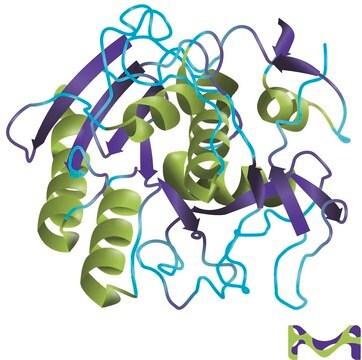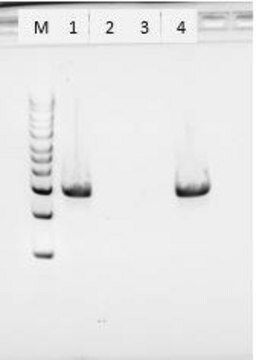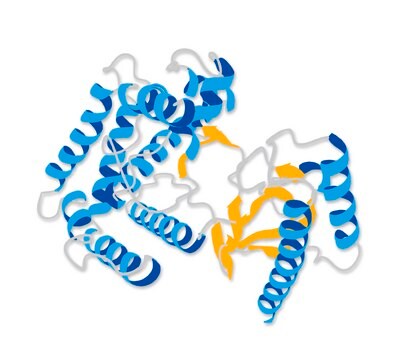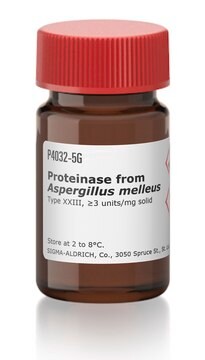Kluczowe dokumenty
P6556
Proteinase K from Tritirachium album
lyophilized powder, ≥30 units/mg protein
Synonim(y):
Endopeptidase K
About This Item
Polecane produkty
Formularz
lyophilized powder
Poziom jakości
aktywność właściwa
≥30 units/mg protein
masa cząsteczkowa
28.93 kDa
metody
DNA extraction: suitable
rozpuszczalność
H2O: soluble 1 mg/mL, clear, colorless
obecność zanieczyszczeń
Dnase ≤30 Kunitz units/mg solid
RNase ≤0.003 Kunitz units/mg solid
Warunki transportu
wet ice
temp. przechowywania
−20°C
Szukasz podobnych produktów? Odwiedź Przewodnik dotyczący porównywania produktów
Zastosowanie
It is used for the removal of endotoxins bound to cationic proteins such as lysozyme and ribonuclease A.
It is useful for the isolation of hepatic, yeast, and mung bean mitochondria
and is used to determine enzyme localization on membranes
It is used for the treatment of paraffin embedded tissue sections to expose antigen binding sites for antibody labeling and
for digestion of proteins from brain tissue samples for prions in Transmissible Spongiform Encephalopathies (TSE) research. Product P6556 is provided as a lyophilized powder. Product P6556 has been used to break down human lens protein.
Removes endotoxins that bind to cationic proteins such as lysozyme and ribonuclease A.
Reported useful for the isolation of hepatic, yeast, and mung bean mitochondria
Determination of enzyme localization on membranes
Treatment of paraffin embedded tissue sections to expose antigen binding sites for antibody labeling.
Digestion of proteins from brain tissue samples for prions in Transmissible Spongiform Encephalopathies (TSE) research.
Działania biochem./fizjol.
Definicja jednostki
najczęściej kupowane z tym produktem
Hasło ostrzegawcze
Danger
Zwroty wskazujące rodzaj zagrożenia
Zwroty wskazujące środki ostrożności
Klasyfikacja zagrożeń
Eye Irrit. 2 - Resp. Sens. 1 - Skin Irrit. 2 - STOT SE 3
Organy docelowe
Respiratory system
Kod klasy składowania
11 - Combustible Solids
Klasa zagrożenia wodnego (WGK)
WGK 1
Temperatura zapłonu (°F)
Not applicable
Temperatura zapłonu (°C)
Not applicable
Środki ochrony indywidualnej
dust mask type N95 (US), Eyeshields, Faceshields, Gloves
Wybierz jedną z najnowszych wersji:
Masz już ten produkt?
Dokumenty związane z niedawno zakupionymi produktami zostały zamieszczone w Bibliotece dokumentów.
Klienci oglądali również te produkty
Produkty
Proteinaza K pomaga w zastosowaniach biologii molekularnej poprzez trawienie białek strukturalnych, usuwanie nukleaz i izolowanie nienaruszonego genomowego DNA.
Wytyczne dotyczące stosowania proteinazy K, enzymu powszechnie stosowanego do degradacji białek oraz ochrony DNA i RNA przed degradacją w próbkach.
Proteinase K (EC 3.4.21.64) activity can be measured spectrophotometrically using hemoglobin as the substrate. Proteinase K hydrolyzes hemoglobin denatured with urea, and liberates Folin-postive amino acids and peptides. One unit will hydrolyze hemoglobin to produce color equivalent to 1.0 μmol of tyrosine per minute at pH 7.5 at 37 °C (color by Folin & Ciocalteu's Phenol Reagent).
Proteinase K (EC 3.4.21.64) activity can be measured spectrophotometrically using hemoglobin as the substrate. Proteinase K hydrolyzes hemoglobin denatured with urea, and liberates Folin-postive amino acids and peptides. One unit will hydrolyze hemoglobin to produce color equivalent to 1.0 μmol of tyrosine per minute at pH 7.5 at 37 °C (color by Folin & Ciocalteu's Phenol Reagent).
Protokoły
Proteinase K (EC 3.4.21.64) activity can be measured spectrophotometrically using hemoglobin as the substrate. Proteinase K hydrolyzes hemoglobin denatured with urea, and liberates Folin-postive amino acids and peptides. One unit will hydrolyze hemoglobin to produce color equivalent to 1.0 μmol of tyrosine per minute at pH 7.5 at 37 °C (color by Folin & Ciocalteu's Phenol Reagent).
Aktywność proteinazy K mierzona za pomocą spektrofotometrii przy użyciu substratu hemoglobiny, kluczowa dla charakterystyki enzymu.
In Situ Hybridization of Whole-Mount Mouse Embryos with RNA Probes: Hybridization, Washes, and Histochemistry
Nasz zespół naukowców ma doświadczenie we wszystkich obszarach badań, w tym w naukach przyrodniczych, materiałoznawstwie, syntezie chemicznej, chromatografii, analityce i wielu innych dziedzinach.
Skontaktuj się z zespołem ds. pomocy technicznej









